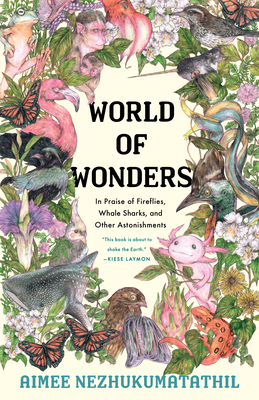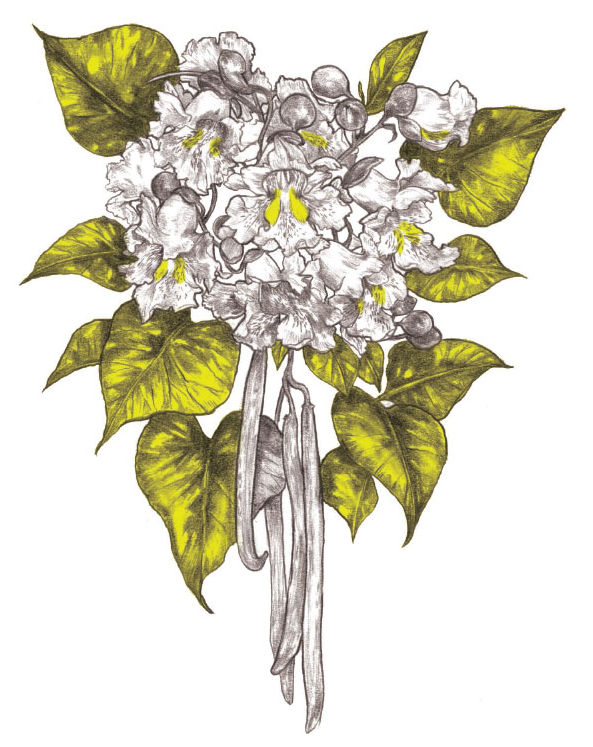World of Wonders
Aimee Nezhukumatathil

Where does one start to take care of these living things amid the dire and daily news of climate change, and reports of another animal or plant vanishing from the planet? How can one even imagine us getting back to a place where we know the names of the trees we walk by every single day? A place where “a bird” navigating a dewy meadow is transformed into something more specific, something we can hold onto by feeling its name on our tongues: brown thrasher. Or “that big tree”: catalpa. Maybe what we can do when we feel overwhelmed is to start small. Start with what we have loved as kids and see where that leads us.
When I was a kid growing up in the Blue Ridge Mountains of Virginia, my dad became close with an elderly couple who went to our church. Their names were Mary Linda and Ellison Smyth. Rhymes with “blithe.” They were in their late eighties and early nineties when I knew them in the early 1990s, but were in great mental and physical shape for most of that time. They lived in a retirement community near us, and mainly I remember meeting up with them to take walks in the woods. On these walks, they would always point out different plants to us, and show us how to recognize them. Oak. Maple. Hickory. When said by Ellison, inevitably followed by “dickory dock.” Sassafras. Wintergreen. On the rare occasions when 90-year-old memories faltered, “whangdoodle.” I remember how extraordinary a revelation it seemed (and really, still does!) that, if you knew enough about plants, you could simply pluck some of them out of the ground and eat them as a normal part of your walk. I have an especially vivid memory of Mary Linda showing me the glove-like leaves of the sassafras plant, and demonstrating how you could just pull up the whole plant and chew on the root-beer-flavored root, and if there was a little dirt on it, so what?
The Smyths introduced me to the eponymous “world of wonder” of Aimee Nezhukumatathil’s book: the precious animals and plants that we share the earth with, sometimes far, sometimes in our backyards. In a real way, they were the local rootstock that my sister and I were grafted onto. My family had moved to southwest Virginia right around the time I was born, so we didn’t have any family history in the place, and no biological elders to teach us about its plant and animal life. To this day, any plant I can still identify is probably thanks to Ellison and Mary Linda.
It was only much, much later I learned some of these details from Lura Astor’s October 1992 Roanoke Times article about Mary Linda, which is worth a read in its entirety. that I pieced together what an extraordinary person Mary Linda in particular must have been. She was born in North Carolina in 1904, and earned a master’s degree in botany from UNC Chapel Hill in 1933–I can’t imagine it was easy being a woman graduate student in the sciences in the 1930s! She became a professor at Virginia Tech and continued working in the Massey Herbarium there until her retirement at age 88, at which time she was most likely the oldest employee of the state of Virginia. She collected some 6,000 plant samples over the course of her career.
These days, I rely on the iNaturalist app I learned about this app from Jenny Odell’s inspiring book, How to Do Nothing. for identifying things in nature. It’s certainly no substitute for a kindly old professional botanist pointing things out to you, but just like Nezhukumatathil says in the quote I included above, learning the names of things (and keeping my eyes open for new things to identify!) does a lot to enhance my enjoyment of nature. Here are just a few of the things I’ve been able to ID on recent walks near my home in Connecticut: Fan clubmoss. Winterberry holly. Fireweed. Red chanterelle. Daisy fleabane. Common selfheal. Pointed-leaved tick-trefoil. And just the other day, I saw a plant and told my partner, “I’m pretty sure that’s sassafras.” I was right!
For Aimee Nezhukumatathil, plants and animals
 Catalpa illustration by
Fumi Nakamura
are wondrous not just because of their objective physical and biological properties, but also and more importantly because of their roles in connecting us to the sense-memories of particular times and places in our lives. “A single firefly might be the spark that sends us back to our grandmother’s backyard to listen for whip-poor-wills, the spark that sends us back to splashing in an ice-cold creek bed, with our jeans rolled up to our knees, until we shudder and gasp, our toes fully wrinkled,” she writes. “In that spark is a slowdown and a tenderness.” World of Wonders itself is a collection of essays drawing on this connection, discussing a plant or animal and a role it played, literal or metaphorical, at some time and place in her own life, accompanied by lovely illustrations by Fumi Mini Nakamura.
Catalpa illustration by
Fumi Nakamura
are wondrous not just because of their objective physical and biological properties, but also and more importantly because of their roles in connecting us to the sense-memories of particular times and places in our lives. “A single firefly might be the spark that sends us back to our grandmother’s backyard to listen for whip-poor-wills, the spark that sends us back to splashing in an ice-cold creek bed, with our jeans rolled up to our knees, until we shudder and gasp, our toes fully wrinkled,” she writes. “In that spark is a slowdown and a tenderness.” World of Wonders itself is a collection of essays drawing on this connection, discussing a plant or animal and a role it played, literal or metaphorical, at some time and place in her own life, accompanied by lovely illustrations by Fumi Mini Nakamura.
For me, World of Wonders had a feel of universality, not because Nezhukumatathil’s experiences are generic, but just the reverse: she describes such a great variety of her own idiosyncratic experiences in the book’s few pages that I think anyone would find things to relate to. Here was one that resonated for me. In the essay “Superb Bird of Paradise,” Nezhukumatathil is talking about her wedding day. The DJ was sick and sent a sub. The couple had given him free reign, except for three blacklisted songs. The pinch-DJ nonetheless plays the (forbidden) Macarena:
But then something extraordinary happened. Not only did everyone take to the floor when “Macarena” blasted over the speakers, but because of its interactive nature, everyone was dancing with each other. My husband's cousin from western Kansas was facing my second uncle from India with outstretched hands. A distant cousin was shaking her hips, wrapped in a pink sari, at one of my best friends from grad school. My husband's grandparents popped their hands behind their heads alongside my dear Filipino friends from New York City, Joseph and Sarah. How did everyone know this dance?!
My partner and I had a very similar experience at our own wedding, which was the first time we really brought together her Filipinx-American family and my white, mostly Midwestern family. We had decided on a square dance band and caller for our music, and it had the same effect of getting all the different people we invited dancing together, in a really lovely way. Everyone likes dancing when there are easy directions to follow!
Nezhukumatathil has this to say about the nature of wonder, in the final essay of the book: “it takes a bit of patience, and it takes putting yourself in the right place at the right time.” All true, but I’d add to that: it also helps a lot to have someone to help cultivate your capacity for wonder–be they an essayist or a kindly old botanist.